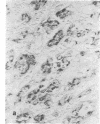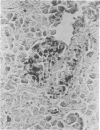Abstract
A monoclonal antibody to a synthetic peptide consisting of residues 8-17 of the amyloid beta protein of Alzheimer disease was used in immunohistochemical studies to reveal binding sites for this peptide in vesicular elements in the islets of Langerhans of the pancreas and the zona reticularis of the adrenal gland. These binding sites may represent a specific membrane receptor. These results, together with similarities in structural features between the precursors for epidermal growth factor and beta protein, suggest that the beta-protein precursor may be processed to release an active peptide ligand rather than acting as a membrane receptor. In Alzheimer disease, abnormal processing of this active peptide precursor may result in the deposition of beta-protein amyloid fibrils in the brain.
Full text
PDF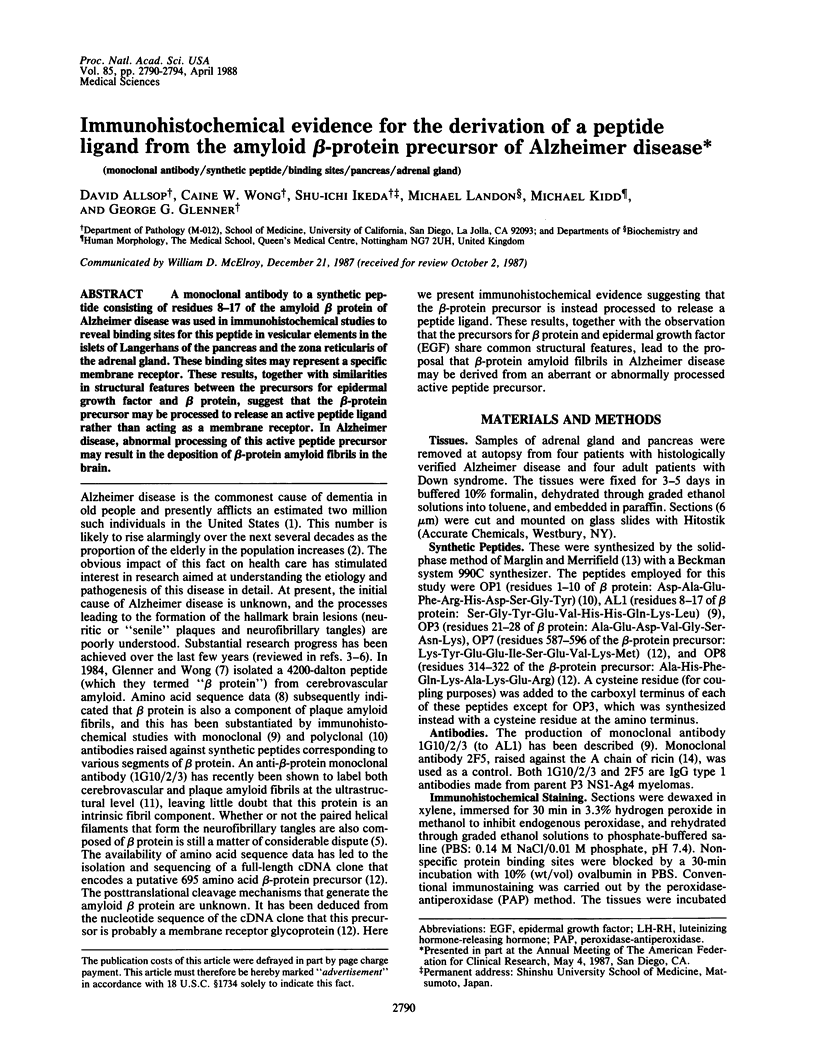
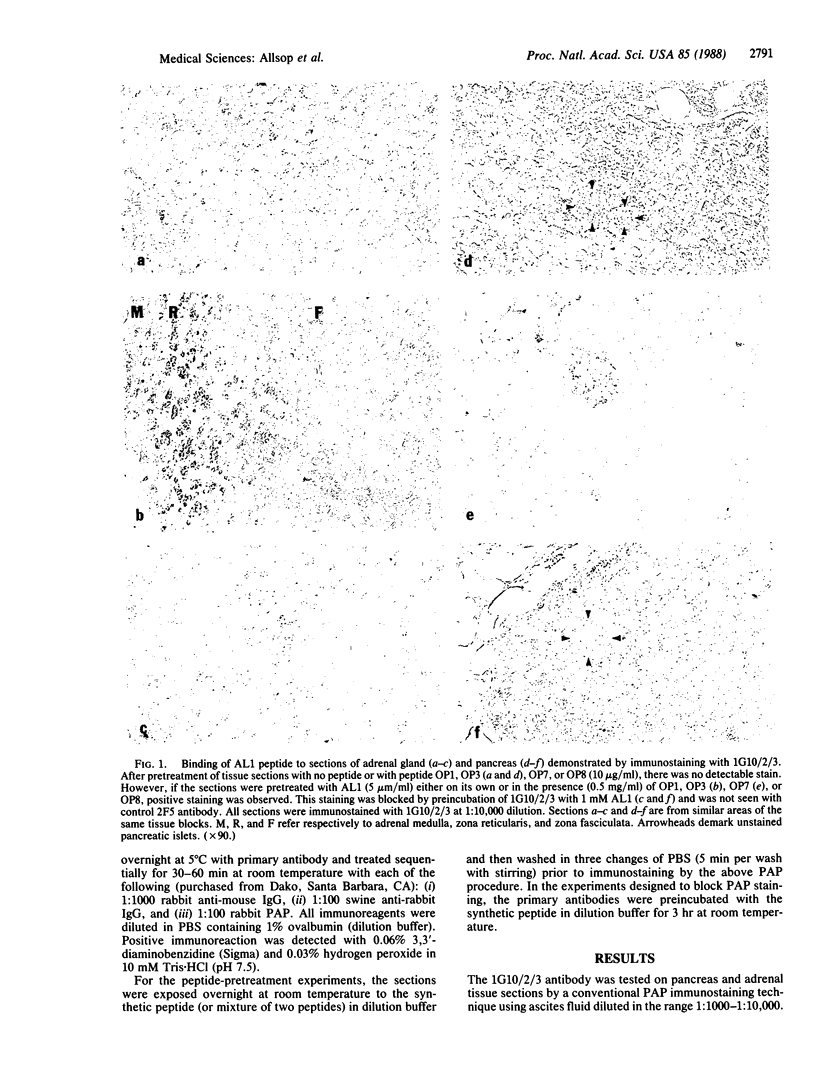
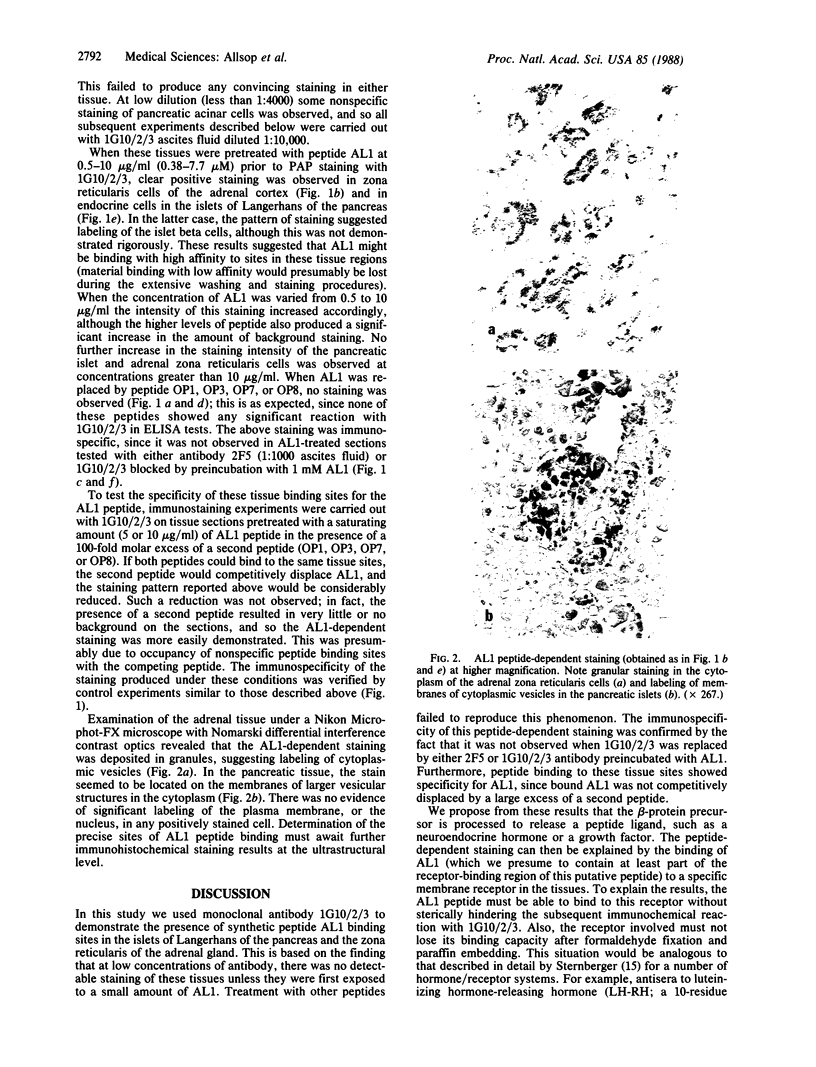
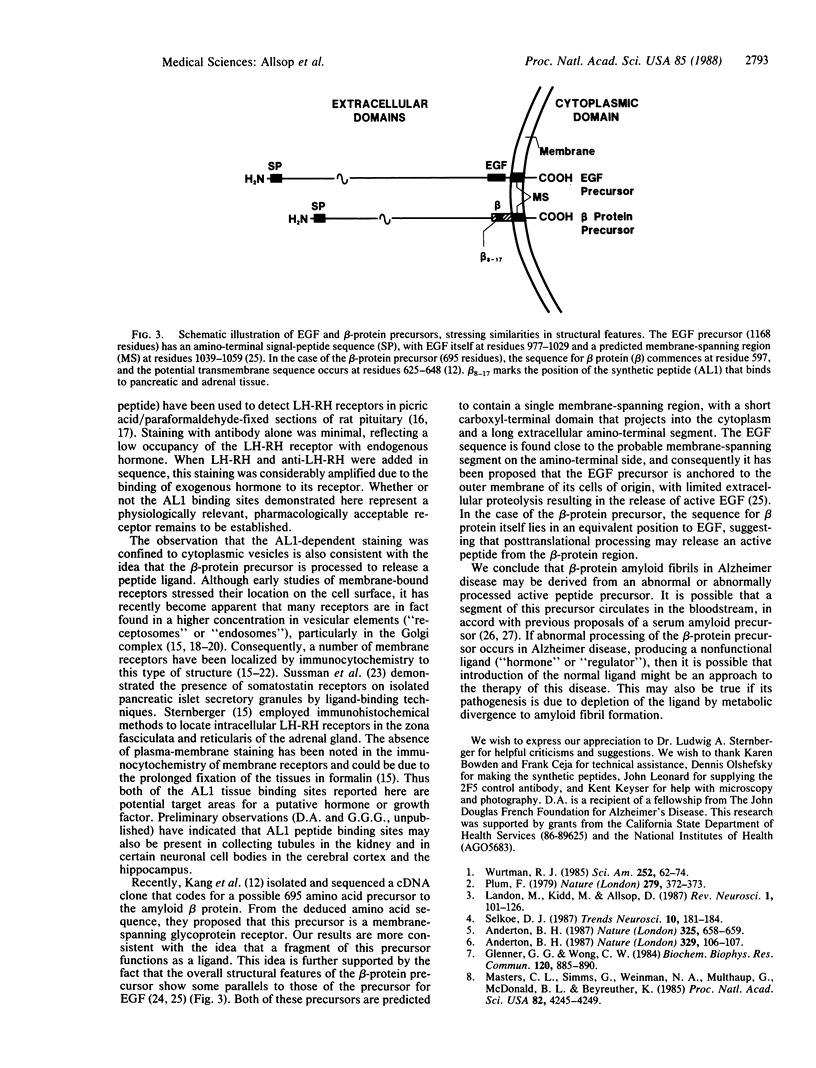
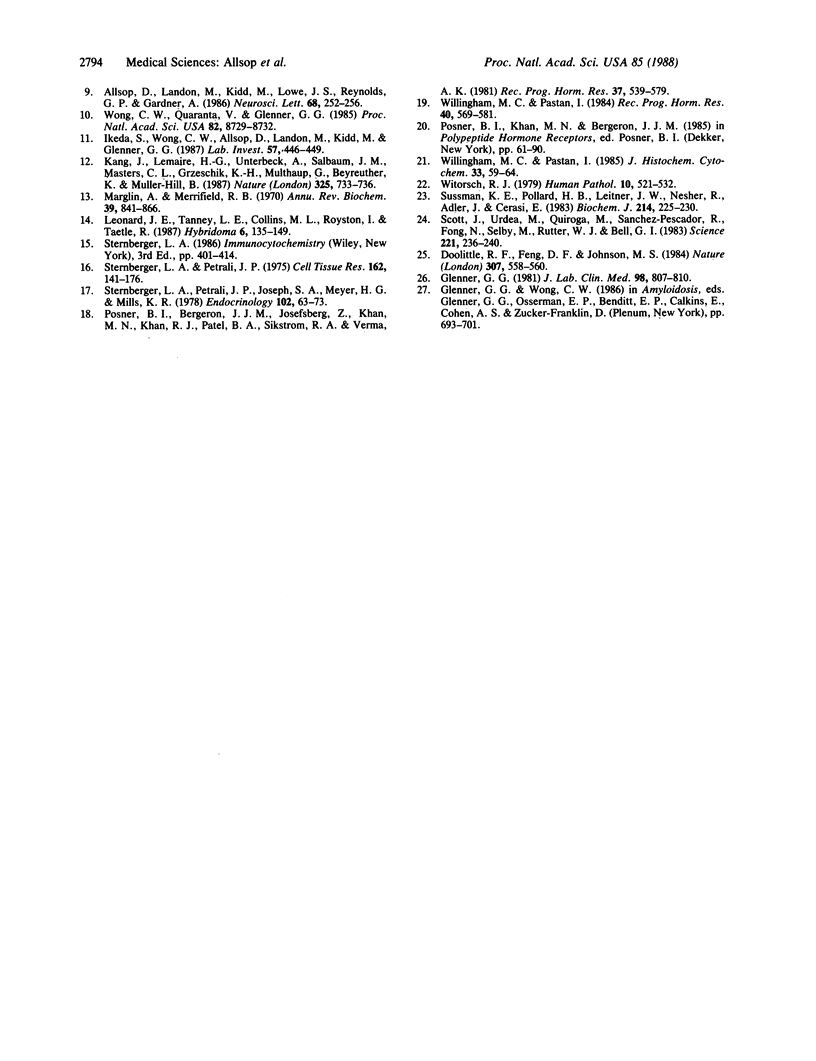
Images in this article
Selected References
These references are in PubMed. This may not be the complete list of references from this article.
- Allsop D., Landon M., Kidd M., Lowe J. S., Reynolds G. P., Gardner A. Monoclonal antibodies raised against a subsequence of senile plaque core protein react with plaque cores, plaque periphery and cerebrovascular amyloid in Alzheimer's disease. Neurosci Lett. 1986 Jul 24;68(2):252–256. doi: 10.1016/0304-3940(86)90152-7. [DOI] [PubMed] [Google Scholar]
- Anderton B. H. Alzheimer's disease. Progress in molecular pathology. Nature. 1987 Feb 19;325(6106):658–659. doi: 10.1038/325658a0. [DOI] [PubMed] [Google Scholar]
- Anderton B. H. Alzheimer's disease. Tangled genes and proteins. Nature. 1987 Sep 10;329(6135):106–107. doi: 10.1038/329106a0. [DOI] [PubMed] [Google Scholar]
- Doolittle R. F., Feng D. F., Johnson M. S. Computer-based characterization of epidermal growth factor precursor. Nature. 1984 Feb 9;307(5951):558–560. doi: 10.1038/307558a0. [DOI] [PubMed] [Google Scholar]
- Glenner G. G. Amyloidosis: the hereditary disorders, including Alzheimer's disease. J Lab Clin Med. 1981 Dec;98(6):807–810. [PubMed] [Google Scholar]
- Glenner G. G., Wong C. W. Alzheimer's disease: initial report of the purification and characterization of a novel cerebrovascular amyloid protein. Biochem Biophys Res Commun. 1984 May 16;120(3):885–890. doi: 10.1016/s0006-291x(84)80190-4. [DOI] [PubMed] [Google Scholar]
- Ikeda S., Wong C. W., Allsop D., Landon M., Kidd M., Glenner G. G. Immunogold labeling of cerebrovascular and neuritic plaque amyloid fibrils in Alzheimer's disease with an anti-beta protein monoclonal antibody. Lab Invest. 1987 Oct;57(4):446–449. [PubMed] [Google Scholar]
- Kang J., Lemaire H. G., Unterbeck A., Salbaum J. M., Masters C. L., Grzeschik K. H., Multhaup G., Beyreuther K., Müller-Hill B. The precursor of Alzheimer's disease amyloid A4 protein resembles a cell-surface receptor. Nature. 1987 Feb 19;325(6106):733–736. doi: 10.1038/325733a0. [DOI] [PubMed] [Google Scholar]
- Leonard J. E., Tanney L. E., Collins M. L., Royston I., Taetle R. Monoclonal antibodies to purified ricin A-chain: production and properties. Hybridoma. 1987 Apr;6(2):135–149. doi: 10.1089/hyb.1987.6.135. [DOI] [PubMed] [Google Scholar]
- Marglin A., Merrifield R. B. Chemical synthesis of peptides and proteins. Annu Rev Biochem. 1970;39:841–866. doi: 10.1146/annurev.bi.39.070170.004205. [DOI] [PubMed] [Google Scholar]
- Masters C. L., Simms G., Weinman N. A., Multhaup G., McDonald B. L., Beyreuther K. Amyloid plaque core protein in Alzheimer disease and Down syndrome. Proc Natl Acad Sci U S A. 1985 Jun;82(12):4245–4249. doi: 10.1073/pnas.82.12.4245. [DOI] [PMC free article] [PubMed] [Google Scholar]
- Plum F. Dementia: an approaching epidemic. Nature. 1979 May 31;279(5712):372–373. doi: 10.1038/279372a0. [DOI] [PubMed] [Google Scholar]
- Scott J., Urdea M., Quiroga M., Sanchez-Pescador R., Fong N., Selby M., Rutter W. J., Bell G. I. Structure of a mouse submaxillary messenger RNA encoding epidermal growth factor and seven related proteins. Science. 1983 Jul 15;221(4607):236–240. doi: 10.1126/science.6602382. [DOI] [PubMed] [Google Scholar]
- Sternberger L. A., Petrali J. P., Joseph S. A., Meyer H. G., Mills K. R. Specificity of the immunocytochemical luteinizing hormone-releasing hormone receptor reaction. Endocrinology. 1978 Jan;102(1):63–73. doi: 10.1210/endo-102-1-63. [DOI] [PubMed] [Google Scholar]
- Sternberger L. A., Petrali J. P. Quantitative immunocytochemistry of pituitary receptors for luteinizing hormone-releasing hormone. Cell Tissue Res. 1975 Sep 17;162(2):141–176. doi: 10.1007/BF00209204. [DOI] [PubMed] [Google Scholar]
- Sussman K. E., Pollard H. B., Leitner J. W., Nesher R., Adler J., Cerasi E. Differential control of insulin secretion and somatostatin-receptor recruitment in isolated pancreatic islets. Biochem J. 1983 Jul 15;214(1):225–230. doi: 10.1042/bj2140225. [DOI] [PMC free article] [PubMed] [Google Scholar]
- Willingham M. C., Pastan I. Endocytosis and membrane traffic in cultured cells. Recent Prog Horm Res. 1984;40:569–587. doi: 10.1016/b978-0-12-571140-1.50018-9. [DOI] [PubMed] [Google Scholar]
- Willingham M. C., Pastan I. Ultrastructural immunocytochemical localization of the transferrin receptor using a monoclonal antibody in human KB cells. J Histochem Cytochem. 1985 Jan;33(1):59–64. doi: 10.1177/33.1.2856926. [DOI] [PubMed] [Google Scholar]
- Witorsch R. J. The application of immunoperoxidase methodology for the visualization of prolactin binding sites in human prostate tissue. Hum Pathol. 1979 Sep;10(5):521–532. doi: 10.1016/s0046-8177(79)80096-9. [DOI] [PubMed] [Google Scholar]
- Wong C. W., Quaranta V., Glenner G. G. Neuritic plaques and cerebrovascular amyloid in Alzheimer disease are antigenically related. Proc Natl Acad Sci U S A. 1985 Dec;82(24):8729–8732. doi: 10.1073/pnas.82.24.8729. [DOI] [PMC free article] [PubMed] [Google Scholar]
- Wurtman R. J. Alzheimer's disease. Sci Am. 1985 Jan;252(1):62-6, 71-4. doi: 10.1038/scientificamerican0185-62. [DOI] [PubMed] [Google Scholar]









